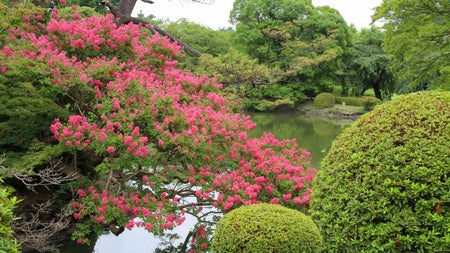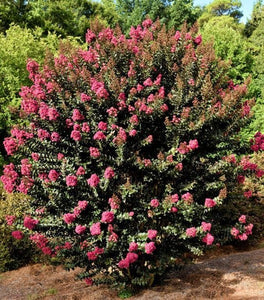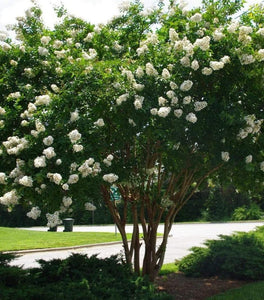
Images Depict Mature Plants
Ebony Glow Crape Myrtle
Ebony Glow Crape Myrtle is a stunning, compact variety prized for its striking combination of dark burgundy-black foliage and soft pink flower clusters. This eye-catching contrast provides unique, season-long interest, making Ebony Glow a standout addition to sunny landscapes. Blooming from mid-summer through fall, the lush pink blossoms pop against the rich, dark leaves, creating an elegant and colorful focal point. Reaching about 10 to 12 feet tall and 8 feet wide at maturity, Ebony Glow Crape Myrtle is perfectly sized for foundation plantings, small ornamental trees, privacy screens, or colorful borders.
Adaptable and easy to care for, Ebony Glow Crape Myrtle thrives in full sun and well-draining soil, where it will reward you with vibrant growth and abundant blooms with minimal effort. This variety is highly resistant to common Crape Myrtle diseases like powdery mildew and leaf spot, making it a low-maintenance choice for gardeners seeking dependable beauty. Ebony Glow is also drought-tolerant once established, making it ideal for hot, dry climates or low-water landscapes. Its upright growth habit and rich foliage color add not only beauty but also structure and definition to modern and traditional garden designs alike.
In addition to its breathtaking appearance, Ebony Glow Crape Myrtle supports a healthy garden ecosystem by attracting bees, butterflies, and other beneficial pollinators. Its extended bloom period ensures a reliable source of nectar when other flowering plants may be dormant. Whether planted as a single specimen, used in groupings for a dramatic effect, or featured in a pollinator-friendly garden, Ebony Glow delivers powerful color and lasting charm. Choose Ebony Glow Crape Myrtle for a bold yet refined addition that brings multi-season interest, wildlife appeal, and effortless elegance to your landscape.

| Hardiness Zone: | 7-9 |
|---|---|
| Mature Height: | 10 to 12 feet |
| Mature Width: | 6 to 8 feet |
| Classification: | mid-sized tree form (up to 12 feet) |
| Sunlight: | Full Sun |
| Habit: | Deciduous, densely branched, multi-stemmed summer through the first frost |
| Flower Color: | blush-pink to white flowers in mid to late summer through the first frost |
| Foliage: | New growth emerges a rich dark purple black |
| Soil Condition: | Any well drained soil |
| Water Requirements: | Water well until established |
| Uses: | Extremely attractive when used as a focal point in the mixed border, mass planting, or a specimen planting |
How to Care for Ebony Glow Crape Myrtle
Be sure to read our planting instructions to ensure a healthy and happy Ebony Glow Crape Myrtle for years to come!
How Should I Plant My Ebony Glow Crape Myrtle?
To plant your Ebony Glow Crape Myrtle successfully, start by selecting a location that receives full sun for at least six hours a day to promote the best flowering and foliage color. Dig a hole that is twice as wide as the root ball and just as deep, loosening the surrounding soil to encourage strong root growth. Place the Ebony Glow in the hole with the top of the root ball level with the soil surface, backfill with a mix of native soil and compost, and water thoroughly to settle the soil around the roots. Applying a 2–3 inch layer of mulch around the base will help retain moisture, regulate soil temperature, and suppress weeds. When planting your Ebony Glow Crape Myrtle, allow enough space for its mature size of 10 to 12 feet tall and about 8 feet wide. Proper spacing not only gives the plant room to grow but also ensures good air circulation, reducing the risk of disease. If planting multiple Ebony Glow Crape Myrtles for a privacy screen or mass planting, space them approximately 6 to 8 feet apart. Consistent watering during the first growing season is crucial to establishing a healthy root system. With the right planting conditions, Ebony Glow Crape Myrtle will reward you with vibrant foliage, stunning pink flowers, and reliable performance year after year.
How Should I water My Ebony Glow Crape Myrtle?
When watering your Ebony Glow Crape Myrtle, focus on providing deep, thorough soakings to encourage strong, deep root growth. During the first growing season, water your Ebony Glow once or twice a week, depending on rainfall and soil conditions, ensuring the soil remains consistently moist but not soggy. Always water at the base of the plant rather than overhead to help prevent fungal issues like powdery mildew. Deep watering allows the roots to grow downward into the soil, helping your Ebony Glow Crape Myrtle become more drought-tolerant as it matures. Once established, Ebony Glow Crape Myrtle is fairly drought-tolerant and typically requires only occasional supplemental watering during extended dry periods. Always check the soil moisture a few inches below the surface before watering—if it feels dry, it's time to water. Adding a 2–3 inch layer of mulch around the root zone helps retain soil moisture and reduces the need for frequent watering. Proper watering practices will keep your Ebony Glow Crape Myrtle healthy, vibrant, and covered in its stunning soft pink blooms throughout the hot summer months.
How Should I Fertilize My Ebony Glow Crape Myrtle?
To fertilize your Ebony Glow Crape Myrtle properly, apply a balanced, slow-release fertilizer, such as a 10-10-10 or 12-4-8 formula, in early spring as new growth begins to emerge. Spread the fertilizer evenly around the root zone, keeping it a few inches away from the base of the trunk, and water it in thoroughly to activate the nutrients. Fertilizing at the right time promotes vigorous growth, deepens the rich burgundy foliage color, and encourages a long season of soft pink blooms. Avoid high-nitrogen fertilizers, as they can cause excessive leafy growth at the expense of flowers. For the best results, you can lightly fertilize your Ebony Glow Crape Myrtle again in midsummer if growth seems slow or flowering is reduced, but avoid late-season applications that could stimulate tender growth vulnerable to frost. Incorporating organic matter like compost around the root zone can also enhance soil fertility naturally. Always follow the fertilizer package instructions to prevent overfeeding, which can stress the plant. With consistent and thoughtful fertilization, your Ebony Glow Crape Myrtle will reward you with vibrant foliage, prolific blooms, and outstanding overall health year after year.

How and When Should I Prune My Ebony Glow Crape Myrtle?
You should prune your Ebony Glow Crape Myrtle in late winter or very early spring, just before new growth begins to emerge. This timing allows you to clearly see the plant’s structure and prune without accidentally cutting off developing flower buds. Start by removing any dead, damaged, or crossing branches to promote healthy airflow and reduce the risk of disease. Because Ebony Glow has a naturally upright and elegant shape, you’ll only need light, selective pruning to maintain its form and encourage strong, vigorous blooming throughout the summer. When pruning your Ebony Glow Crape Myrtle, avoid the common mistake of cutting back the main branches severely, often referred to as "crape murder." Instead, focus on thinning crowded areas, removing any suckers at the base, and shaping the canopy to highlight the beautiful contrast between the dark foliage and the soft pink flowers. Light deadheading of spent blooms during the growing season can also encourage a second flush of flowers. Proper, gentle pruning will keep your Ebony Glow looking refined, healthy, and full of stunning color from mid-summer through fall.
















